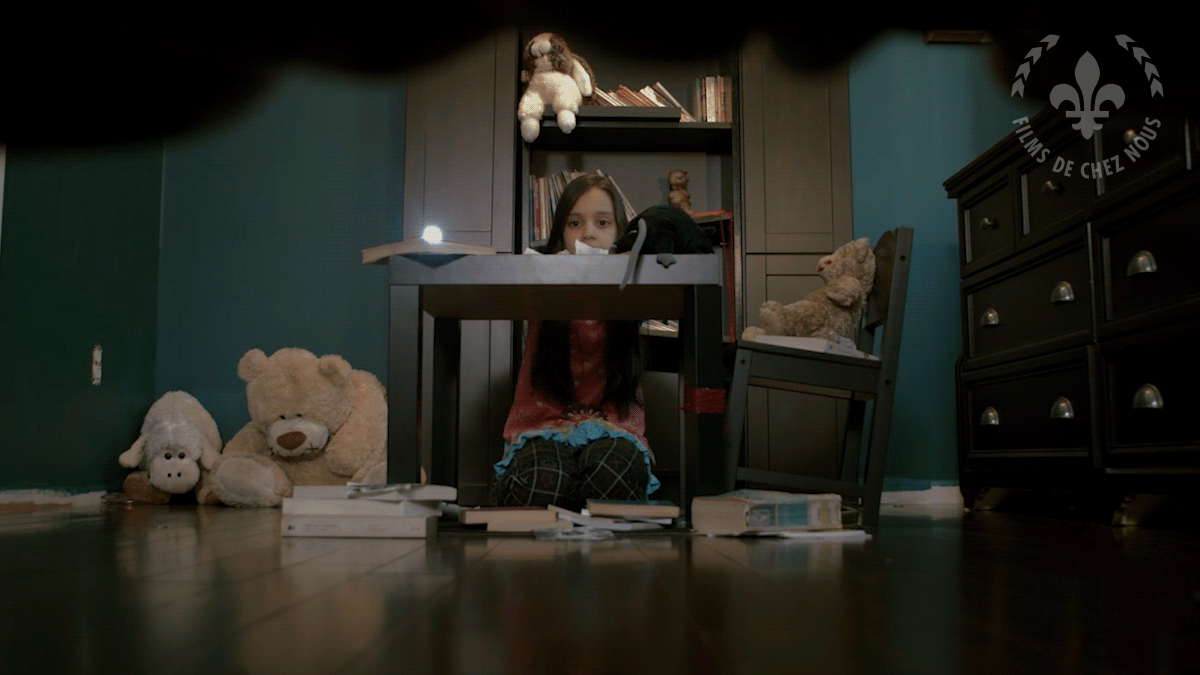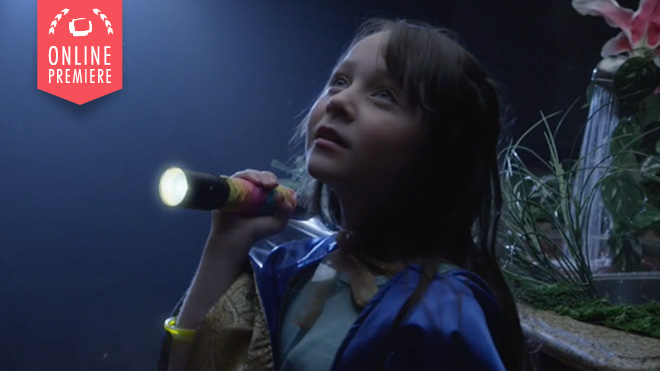Afraid and alone, a young boy must navigate the turmoil of a broken home in order to defeat the terrifying creature that lurks in his basement.
“Dirty Laundry,” a compelling short fantasy/suspense film directed by Aaron Martinez and written and shot by Guy Pooles (The Light and the Little Girl), delves into the gripping narrative of a young boy facing the daunting challenges of a fractured home. With an air of fear and isolation, the film thrusts viewers into the unsettling journey of the protagonist as he confronts a terrifying creature lurking in the shadows of his own basement.
The collaboration between Aaron Martinez and Guy Pooles brings forth a haunting and atmospheric tale that blends elements of fantasy and suspense. As the young boy grapples with the complexities of his broken family, the film promises to unravel layers of emotion and suspense. In anticipation of an insightful interview, join us in exploring the eerie depths of “Dirty Laundry” and the creative minds behind this captivating short film. We spoke with Guy who have us a little more insight on the film and its monsters:
“Dirty Laundry” navigates a young boy’s experience facing a terrifying creature in his basement amidst the turmoil of a broken home. Could you elaborate on the backstory behind this concept, including the inspiration for blending fantasy with the challenges of a broken family?
It started, for me, with the idea of a monster formed from dirty laundry. I liked this idea, as it seemed simultaneously mythical yet also relatable. All of us have experienced moments in our lives where the amount of laundry to be washed has gotten far out of hand, and usually these moments coincide with something else in our lives spiralling out of control. It was a monster whose symbolism was clear: it represented the breakdown of the domestic status quo.
From there I just tried to reverse engineer the best protagonist to face this creature. A child seemed like the logical choice. Not just because seeing a child stand up to a foreboding creature felt inherently compelling, but because, to many young children, a pile of laundry, sentient or not, would seem like an obstacle they hadn’t yet been prepared to face.
From there the rest of the story seemed to fall into place. Why is the laundry piling up? What is going on in his parents’ lives to cause this? I was inspired, at the time, by Guillermo del Toro’s Pan’s Labyrinth, and how he potently juxtaposed the fantastical threads of that story with the very grounded world surrounding them; but how he also ensured that both worlds felt equally stressful. So to counterbalance the presence of the laundry monster in this child’s life, I wanted to find a domestic conflict that could feel comparably mundane, but subjectively just as upsetting. Seeing my parents going through any kind of emotional turmoil was always the most confusing and upsetting thing for me as a young child, so I pulled from that feeling.
How did you approach portraying the emotional impact of this situation on the young protagonist, and how does it intertwine with his confrontation with the terrifying creature?
When we meet our protagonist, Sam, he’s totally lost at sea. When a child is suddenly stripped of their parents, they are often left without the ability to navigate simple daily life. It was important to us to use this concept as a tool to place more pressure upon Sam. Now, not only is there a monster living in his basement, but he also has no clean clothes and must find a way to improvise, and there’s no one to pick him up from school, and he’s being bullied by his classmates. However, he never cries, even though he needs to, instead he tries to reclaim a normal daily routine, and refuses to acknowledge to anyone that anything is wrong. All of these mounting factors build upon each other to exacerbate Sam’s situation, pushing him to the point where he has no choice but to take action; to seek help, and when he doesn’t find it, to confront the issues himself.
The creature in the basement is a central element. Can you discuss its creation and design in relation to the emotional landscape of the film, especially considering the child’s internal struggles amidst familial discord?
Originally in the script, I’d held back on any detailed description of the monster; other than conveying its size. I wished the reader to project their own design for this creature into the story. So, when it came time for Director – Aaron Martinez, myself and the rest of the team to brainstorm how this monster would be presented, there were many different stylistic ideas being discussed. We quickly realised that, although it was tempting to try something stylistically bold, if the design of the monster felt too structural or intricate, the whole aesthetic quickly began to lean towards something quite alien or sci-fi inspired; which didn’t feel quite right for the story we were telling. We never wanted the viewer to lose sight of the fact that this was a monster formed from a giant mound of laundry, so we chose to keep the silhouette quite shapeless. Other than its long arms and protruding head, it’s really just a moving pile of clothes.
The garments that the monster was built from were very carefully selected. They couldn’t be items with too much weight to them as Libby Letlow, one of the three puppeteers of the monster, would be strapped into the head and body of the puppet, and still needed to be able to move and perform beneath the weight of it. The garments also needed to conform to the color palette that Aaron, myself and Production Designer – Shamim Seifzadeh had chosen for the film; stripping the world of warmer, saturated colours and leaning into muted blues and greys.
My favourite part of the final puppet is the head. It was built from the seat of a pair of pants, and the two eyes are the open back pockets of that garment. We placed an LED flashlight into each pocket to allow the eyes to glow and, most crucially, the pockets were rigged so that Libby could make the eyes blink. This small detail brought so much emotion to the otherwise neutral face of the monster, and was so critical in provoking empathy in that final moment of catharsis with Sam.
Keeping the expression of the monster’s face emotionally neutral, allowed the design to move from something intimidating to something quite vulnerable as we, along with the character Sam, project our assumptions about this creature onto that face. The design of the face becomes something of a Rorschach test.
“Dirty Laundry” explores themes of fear and loneliness. How did you use visual and narrative elements to convey these emotions, particularly in depicting the child’s sense of isolation and apprehension within the story?
Director Aaron Martinez and I spent a long time designing the details of our visual language for the film. We chose to embrace image compositions that felt quite oppressive and isolating; often pushing Sam to the far edges of the frame, or leaving plenty of empty space to accentuate how alone he is. This carried over into our design for camera movement in the film. The vast majority of Dirty Laundry has a locked off camera, with no movement what-so-ever. We chose not to even pan or tilt to reframe for the action unfolding within the shot, as we felt that even hinting at the presence of a camera operator would dilute the sense of isolation surrounding Sam. So the camera feels quite unsympathetic, making no allowances for Sam at all, almost disregarding him entirely.
In the third act of the film, once Sam takes his agency into his own hands, this visual mode is shattered and we embrace a handheld camera for the remainder of the film; first to create a sense of nervous unpredictability as he finally faces the monster, then eventually to portray a sense of relaxed relief from the oppressive, locked-off feeling of where the film began.
The basement setting plays a crucial role. Can you discuss its significance in amplifying the tension and emotional depth of the film, both in the context of the child’s struggles and the presence of the creature?
The film is about repression. A child who is unable to process or confront the anxiety he feels about his mother’s depression and his parents’ fraught relationship. What better thematic signifier for emotional repression than a basement? It’s a place where we throw all of the dirty laundry we don’t have the bandwidth to deal with, and let it pile up higher and higher, until it takes on a life of its own and can no longer be ignored.
It was thematically very important to me that this also be the setting of the film’s final scene; the once dark basement is now flooded with daylight, and Sam and his mother can now, finally, emotionally connect with each other. They’ve both entered this place that they had each tried to avoid, and it’s here that they find nothing but each other.
Crafting a story around a child’s internal struggles requires a sensitive approach. How did you ensure authenticity in depicting the young boy’s emotions and experiences amidst the supernatural aspects of the film?
When you’re young, very little of the world makes any sense to you. You simply yearn to take everything in your stride. So the sudden appearance of this laundry monster is utterly mystifying to Sam, but no more so than the rift that has developed between his parents, the reason for his mom’s depression or the motives of the bullies at his school. The supernatural element of the story became a great metaphor for how strange and stressful many aspects of life can seem at that age.
In a way, Sam’s final walk across the basement to tell his mom that he loves her, requires the same strength and courage as crossing that very same basement to fight the monster.
What were the film’s biggest challenges, and how did you overcome them?
Well, I’d written a script, which heavily centres around a basement, for us to shoot in southern California where there are no basements to be found. Being from England, I’d not appreciated this well-known fact about architecture in Los Angeles.
We did an exhaustive search to find a suitable basement, but to no avail. Eventually, our amazing Production Designer – Shamim stepped up and constructed the basement as a set. Really this was the only way it could have worked, as shooting a fight scene between a child with a spear and a large laundry monster in an actual basement location would have been near impossible.
I’d love to recount more anecdotes about other challenges we faced, but truthfully: we all seemed to work really well together as a filmmaking team. We had a great leader in Aaron Martinez and we all worked hard in pre-production to ensure we were sufficiently prepared to take on the challenge of making this film. It was one of the smoothest filmmaking experiences I’ve ever had.
Ultimately, what do you hope viewers take away from “Dirty Laundry”?
It’s a story about a child, but I hope it speaks to truths about the challenges we’re all facing. Asking for help, being there for our loved ones: these are things that often take a surprising amount of courage and fortitude. Mainly, I hope the film brings comfort to anyone who feels emotionally overwhelmed by something that, to others, might seem absurd; we’re all battling our own monsters.
What are your favorite short films out there that keep inspiring you?
Lynne Ramsay’s Gasman is one of the greatest short films ever made, and one I constantly return to and reference.
More recently, a short I saw and really enjoyed was The Rat by Carlen May-Mann. I feel like this film was able to harness the strengths of the short film medium to be unsettling in a truly minimalist way.
I also really adore the film SLUT by Chloe Okuno.




